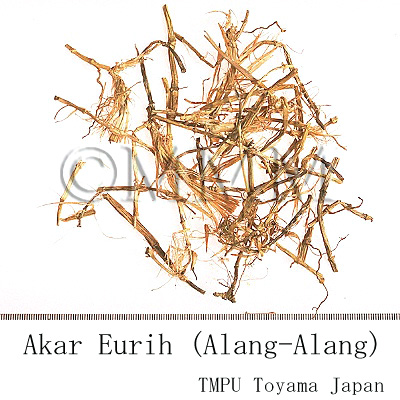Crude drug sample data base
※Click on the image to enlarge it.
The capital city, provincial capital city or the representative
location of its administrative area is indicated.
location of its administrative area is indicated.
Production area information
https://ethmed.toyama-wakan.net/img/pin_san.png
-6.9174639
107.61912280000001
Collection information
Republic of Indonesia,West Java Province
https://ethmed.toyama-wakan.net/img/pin_nyu.png
Scientific information data base
| Crude drug name | Indonesian name, English name | Akar alang-alang | ||||
|---|---|---|---|---|---|---|
| crude drug image |
| |||||
| Original plant name | Imperata cylindrica (L.) P. Beauv. | |||||
| Family name | Gramineae | |||||
| Used part | Roots | |||||
| Distribution area | It occurs wild as a weed throughout Indonesia. Considered as a serious weed, it is usually found in a wide range of open anthropogenic habitats from sea level up to 2700 m altitude [201, 205]. | |||||
| Description | It is a rhizomatous herbaceous perennial up to 1,5 m tall , culms below the nodes usually with a crown of long slender hairs; leaf sheaths of basal leaves coriaceous, glabrous or finely hairy, leaf blade 12-80 cm x 0.5-2 cm; inflorescence a spiciform panicle 10-30 cm long [205]. | |||||
| Drug effect | Cooling, sweet, blood cleanser [231]. | |||||
| Specific actions | Diuretic [201, 231]. | |||||
| Frequency in use | Moderate. | |||||
| Common uses | It is an important source of roofing material which is readily available and durable. It is also used for making paper in paper industries. Despite their weedy characteristics, its massive growth helps in controlling erosion [205]. | |||||
| Pharmacological effect | Cylindol A has shown 5-lipooxygenase activity which may be involved in the anti-inflammatory activity of the plant [205]. Bioactivity-guided fractionation of the methanolic extract of the rhizomes of Imperata cylindrica afforded a new compound, 5-hydroxy-2-(2-phenylethyl)chromone (1), together with three known compounds, 5-hydroxy-2-[2-(2-hydroxyphenyl)ethyl]chromone (2), flidersiachromone (3), and 5-hydroxy-2-styrylchromone (4). Among these four compounds, 1 and 2 showed significant neuroprotective activity against glutamate-induced neurotoxicity in primary cultures of rat cortical cells [PMID: 16499335]. The water-soluble crude extract prepared from Imperata cylindrica (Beauv.) and isolated polysaccharides with high molecular weights were investigated for its immunomodulating activity. Result indicated that both enhance the proliferation of murine splenocytes [PMID: 10483377]. Imperanene, a novel phenolic compound from Imperata cylindrica showed platelet aggregation inhibitory activity [PMID: 7760071]. Graminone B, lignan isolated from Imperata cylindrica showed inhibitory activity on the contraction of the rabbit aorta [PMID: 7714541]. | |||||
| Medical system | Indonesian medicine (Jamu) | |||||
| Traditional usage | A decoction of the rhizome is commonly applied as a diuretic. It is also applied as antipyretic and haemostatic/hemostatic, and thus can be used to cure fever, urinary tract infections, hematemesis [201, 231]. | |||||
| Formulation | 1) Urinary tract infection and lack of urine: - 6 grams of rhizome of I. cylindrica, 5 grams of rhizome of Kaempferia rotunda, 4 grams of Orthosiphon stamineus leaves. - Preparation: all ingredients are boiled or steeped with 115ml of water. Stand to cool, strain. Drink 100ml of the decoction once a day for 14 days. It also can be prepared by mixing all ingredients and made into pills. Take 9 pills 3 times a day for 14 days [231]. | |||||
| References | Reference book Tips! | [201] K. Heyne, Tumbuhan Berguna Indonesia, Vols. 1-4, 1987. Diedarkan Oleh Koperasi Karyawan Departemen Kehutanan, Jakarta, Indonesia. 1 Vol. 1, pp 147-150. [205] de Pdua, L.S., Bunyapraphatsara, N. and Lemmens, R.H.M.J. (Editors), 1990. Plant Resources of South-East Asia No. 12 (1). Medicinal and poisonous plants 1. Backhuys Publishers, Leiden, Netherlands. pp 307-310. [231] Soedibyo, Mooryati: Alam Sumber Kesehatan: Manfaat dan Kegunaan (Natural resources for health. Benefits and uses). Balai Pustaka. 1998. p 55. | ||||
| Research paper | 1. Yoon JS, Lee MK, Sung SH, Kim YC. Neuroprotective 2-(2-phenylethyl)chromones of Imperata cylindrica. J. Nat. Prod., 69(2):290-1, 2006. (PMID: 16499335) 2. Pinilla V, Luu B. Isolation and partial characterization of immunostimulating polysaccharides from Imperata cylindrica. Planta Med., 65(6):549-52, 1999. (PMID: 10483377) 3. Matsunaga K, Shibuya M, Ohizumi Y. Imperanene, a novel phenolic compound with platelet aggregation inhibitory activity from Imperata cylindrica. J. Nat. Prod., 58(1):138-9, 1995. (PMID: 7760071) 4. Matsunaga K, Shibuya M, Ohizumi Y. Graminone B, a novel lignan with vasodilative activity from Imperata cylindrica. J. Nat. Prod., 57(12):1734-6, 1994. (PMID: 7714541) | |||||
| Remarks | [DNA sequences] AB494448, AB494449, AB494450, AB494451, AB494452, AB494453, AB494454, AB494455 Pertaining to geographical regions, a number of varieties have been described for Imperata cylindrica. However, the distinction is at present generally ignored [205]. | |||||
| Last renewal date | 2024/02/29 | |||||




